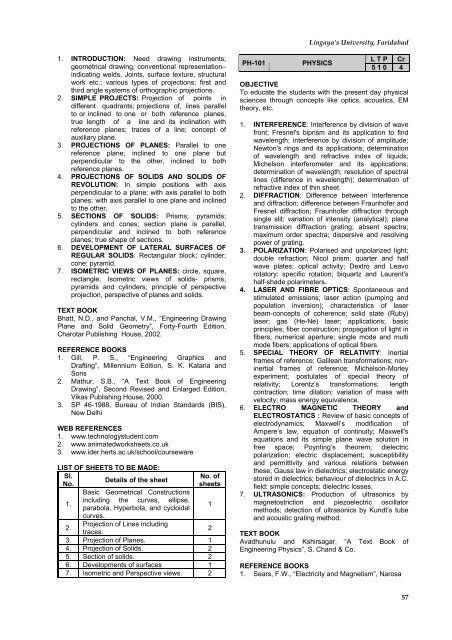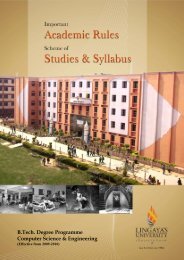B.<strong>Tech</strong>. <strong>Electrical</strong> <strong>Engineering</strong> (Regular)2. Shames, I.H. “<strong>Engineering</strong> Mechanics”, 4thEdition, Pearson Education, 20033. Pytel, A and Kiusalaas, J. Thomsom, “Mechanicsof Materials”, Brooks & Cole, 2003WEB REFERENCESwww.eCourses.ou.eduME-151ENGINEERING L T P CrMECHANICS LAB 0 0 2 1LIST OF EXPERIMENTS1. To study various forces and moments.2. Prove polygon law of coplanar forces, experimentswith pulley systems.3. Find support reactions for simply supported beam4. Find Forces in Truss elements5. Measuring forces in members of jib crane.6. Finding C.G. and MOI of various parts likeconnecting rod. Flywheel using various methods7. To find mechanical advantage and mechanicalefficiency of compound screw jack.8. To study various simple machines including geartrains e.g. Wedge; clock; sewing machine, etc.9. To conduct tensile test and determining ultimatetensile strength percentage elongation of steelspecimen10. To conduct compression test and determinecompressive strength of specimen11. To calculate VR, MA and efficiency of single,doubles and triple start worm and worm wheel12. To study slider crank mechanism of 2 stroke and 4stroke IC engine models13. To study and analyze gear trainsME-152WORKSHOP PRACTICEL T P Cr0 0 4 2OBJECTIVETo provide an overview of the basic productiontechniques and allied / supporting techniques used toproduce finished products from raw materials. In additionto theory, students will be given practical training onvarious basic production techniques. After going throughthis course, the students will be in a position tounderstand the working of a mechanical workshop.1. INTRODUCTION: Basic manufacturing processesand safety in workshop.2. ENGINEERING MATERIALS: Classification ofmaterials–their general mechanical properties andtheir selection3. CASTING PROCESSES: Sand casting process;pattern making; types of moulding sands, cores,mould making, melting and pouring of metal;Casting defects.4. MACHINING PROCESSES: Production ofcomponents involving turning; facing; taper turning;milling; shaping; planning and drilling operations.5. METAL FORMING PROCESSES: Sheet metalforming operations; shearing, bending, punchingand blanking, forging processes as upsetting,drawing down, bending etc.6. JOINING PROCESSES: Metal arc welding; gaswelding; resistance welding; soldering andmechanical fastening processes.7. FITTING AND MAINTENANCE: Study of fittingtools, marking tools and measuring instrumentslike micrometer, vernier calipers and height gauge;introduction to some basic maintenancetechniques/processes.TEXT BOOKRaghuwanshi, B.S., “A course in Workshop<strong>Tech</strong>nology, Vol. I & II”, Dhanpatrai & Co.REFERENCE BOOKHazra & Chaudhary, “Workshop <strong>Tech</strong>nology Vol. I & II”,Asian Book Co.NOTES1. In all sections of workshop, students will studyabout the tools used, different operationsperformed and main parts of the machine2. Term final evaluation will be done on the basis ofdoing a practical job and viva-voce. There will beno theory paper on this subject.JOBS TO BE DONEA. Machine Shop1. To prepare a job on a lathe involving facing,turning, taper turning, step turning, radiusmaking and parting off.2. To prepare horizontal surface/ vertical surface/ curved surface/ slot or v-grooves on ashaper / planer.3. To prepare a job involving side and facemilling on a milling machine.4. To prepare a job involving drilling and tappingof holes.B. Sheet Metal Work1. To draw layout, do marking and prepare arectangular tray of sheet metal.2. To draw layout, do marking and prepare afunnel of sheet metal.C. Foundry1. To prepare a single piece pattern mould, putmetal in the mould and fettle the casting.2. To prepare a split piece pattern mould.D. Welding1. To prepare joints (Lap and butt) by metal arcwelding2. To prepare welded joint by resistance weldingE. Fitting and Maintenance Jobs1. Fitting jobs involving, chipping, filing, markingand measuring with precision instruments.2. Maintenance and repair of common domesticappliances such as desert cooler, LPG stove,room heater, water tap, flush system, electriciron, scooter etc.ME-153ENGINEERING GRAPHICSL T P Cr0 0 6 3OBJECTIVE<strong>Engineering</strong> graphics is the primary medium fordevelopment and communicating design concepts.Through this course the students are trained inengineering Graphics concepts through manualdrafting. The ISI code of practice is followed. With thiscourse students can improve the visual concepts in allengineering streams.56
Lingaya’s University, Faridabad1. INTRODUCTION: Need drawing instruments;geometrical drawing, conventional representation–indicating welds, Joints, surface texture, structuralwork etc.; various types of projections; first andthird angle systems of orthographic projections.2. SIMPLE PROJECTS: Projection of points indifferent quadrants; projections of, lines parallelto or inclined to one or both reference planes,true length of a line and its inclination withreference planes; traces of a line; concept ofauxiliary plane.3. PROJECTIONS OF PLANES: Parallel to onereference plane; inclined to one plane butperpendicular to the other, inclined to bothreference planes.4. PROJECTIONS OF SOLIDS AND SOLIDS OFREVOLUTION: In simple positions with axisperpendicular to a plane; with axis parallel to bothplanes; with axis parallel to one plane and inclinedto the other.5. SECTIONS OF SOLIDS: Prisms; pyramids;cylinders and cones; section plane is parallel,perpendicular and inclined to both referenceplanes; true shape of sections.6. DEVELOPMENT OF LATERAL SURFACES OFREGULAR SOLIDS: Rectangular block; cylinder;cone; pyramid.7. ISOMETRIC VIEWS OF PLANES: circle, square,rectangle; Isometric views of solids- prisms,pyramids and cylinders; principle of perspectiveprojection, perspective of planes and solids.TEXT BOOKBhatt, N.D., and Panchal, V.M., “<strong>Engineering</strong> DrawingPlane and Solid Geometry”, Forty-Fourth Edition,Charotar Publishing House, 2002.REFERENCE BOOKS1. Gill, P. S., “<strong>Engineering</strong> Graphics andDrafting”, Millennium Edition, S. K. Kataria andSons2. Mathur, S.B., “A Text Book of <strong>Engineering</strong>Drawing”, Second Revised and Enlarged Edition,Vikas Publishing House, 2000.3. SP 46-1988, Bureau of Indian Standards (BIS),New DelhiWEB REFERENCES1. www.technologystudent.com2. www.animatedworksheets.co.uk3. www.ider.herts.ac.uk/school/coursewareLIST OF SHEETS TO BE MADE:Sl.Details of the sheetNo.Basic Geometrical Constructionsincluding the curves, ellipse,1.parabola, Hyperbola, and cycloidalcurves.Projection of Lines including2.No. ofsheetstraces.3. Projection of Planes. 14. Projection of Solids. 25. Section of solids. 26. Developments of surfaces 17. Isometric and Perspective views. 212PH-101PHYSICSL T P Cr5 1 0 4OBJECTIVETo educate the students with the present day physicalsciences through concepts like optics, acoustics, EMtheory, etc.1. INTERFERENCE: Interference by division of wavefront; Fresnel's biprism and its application to findwavelength; interference by division of amplitude;Newton's rings and its applications; determinationof wavelength and refractive index of liquids;Michelson interferometer and its applications;determination of wavelength; resolution of spectrallines (difference in wavelength); determination ofrefractive index of thin sheet.2. DIFFRACTION: Difference between Interferenceand diffraction; difference between Fraunhofer andFresnel diffraction; Fraunhofer diffraction throughsingle slit; variation of intensity (analytical); planetransmission diffraction grating; absent spectra;maximum order spectra; dispersive and resolvingpower of grating.3. POLARIZATION: Polarised and unpolarized light;double refraction; Nicol prism; quarter and halfwave plates; optical activity; Dextro and Leavorotatory; specific rotation; biquartz and Laurent'shalf-shade polarimeters.4. LASER AND FIBRE OPTICS: Spontaneous andstimulated emissions; laser action (pumping andpopulation inversion); characteristics of laserbeam-concepts of coherence; solid state (Ruby)laser; gas (He-Ne) laser; applications; basicprinciples; fiber construction; propagation of light infibers; numerical aperture; single mode and multimode fibers; applications of optical fibers.5. SPECIAL THEORY OF RELATIVITY: Inertialframes of reference; Galilean transformations; noninertialframes of reference; Michelson-Morleyexperiment; postulates of special theory ofrelativity; Lorentz’s transformations; lengthcontraction; time dilation; variation of mass withvelocity; mass energy equivalence.6. ELECTRO MAGNETIC THEORY andELECTROSTATICS : Review of basic concepts ofelectrodynamics; Maxwell’s modification ofAmpere’s law, equation of continuity; Maxwell'sequations and its simple plane wave solution infree space; Poynting’s theorem; dielectricpolarization; electric displacement; susceptibilityand permittivity and various relations betweenthese; Gauss law in dielectrics; electrostatic energystored in dielectrics; behaviour of dielectrics in A.C.field: simple concepts; dielectric losses.7. ULTRASONICS: Production of ultrasonics bymagnetostriction and piezoelectric oscillatormethods; detection of ultrasonics by Kundt’s tubeand acoustic grating method.TEXT BOOKAvadhunulu and Kshirsagar, “A Text Book of<strong>Engineering</strong> Physics”, S. Chand & Co.REFERENCE BOOKS1. Sears, F.W., “Electricity and Magnetism”, Narosa57
- Page 1 and 2:
B.Tech. Degree ProgrammeElectrical
- Page 5 and 6:
Lingaya’s University, FaridabadAB
- Page 7 and 8:
IMPORTANT ACADEMIC RULESB.Tech. Deg
- Page 9 and 10: Lingaya’s University, Faridabadac
- Page 11 and 12: Lingaya’s University, FaridabadSe
- Page 13 and 14: Lingaya’s University, FaridabadIn
- Page 15 and 16: CATEGORY-WISE LIST OF COURSESLingay
- Page 17 and 18: Lingaya’s University, FaridabadSU
- Page 19 and 20: Lingaya’s University, FaridabadSc
- Page 22 and 23: B.Tech. Electrical Engineering (Reg
- Page 24 and 25: B.Tech. Electrical Engineering (Reg
- Page 26 and 27: B.Tech. Electrical Engineering (Reg
- Page 28 and 29: B.Tech. Electrical Engineering (Reg
- Page 30 and 31: B.Tech. Electrical Engineering (Reg
- Page 32 and 33: B.Tech. Electrical Engineering (Reg
- Page 34 and 35: B.Tech. Electrical Engineering (Reg
- Page 36 and 37: B.Tech. Electrical Engineering (Reg
- Page 38 and 39: B.Tech. Electrical Engineering (Reg
- Page 40 and 41: B.Tech. Electrical Engineering (Reg
- Page 42 and 43: B.Tech. Electrical Engineering (Reg
- Page 44 and 45: B.Tech. Electrical Engineering (Reg
- Page 46 and 47: B.Tech. Electrical Engineering (Reg
- Page 48 and 49: B.Tech. Electrical Engineering (Reg
- Page 50 and 51: B.Tech. Electrical Engineering (Reg
- Page 52 and 53: B.Tech. Electrical Engineering (Reg
- Page 54 and 55: B.Tech. Electrical Engineering (Reg
- Page 56 and 57: B.Tech. Electrical Engineering (Reg
- Page 58 and 59: B.Tech. Electrical Engineering (Reg
- Page 62 and 63: B.Tech. Electrical Engineering (Reg
- Page 64 and 65: B.Tech. Electrical Engineering (Reg
- Page 66 and 67: B.Tech. Electrical Engineering (Reg
- Page 68 and 69: B.Tech. Electrical Engineering (Reg
- Page 71 and 72: OPEN ELECTIVELingaya’s University
- Page 73 and 74: Lingaya’s University, Faridabadch
- Page 75 and 76: Lingaya’s University, Faridabad4
- Page 77 and 78: Lingaya’s University, Faridabad6.
- Page 79 and 80: Lingaya’s University, FaridabadEL
- Page 81 and 82: Lingaya’s University, Faridabad5
- Page 83 and 84: Lingaya’s University, Faridabador
- Page 85 and 86: Lingaya’s University, Faridabad4.
- Page 87: Lingaya’s University, Faridabad83
















